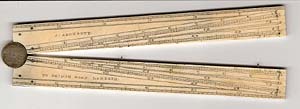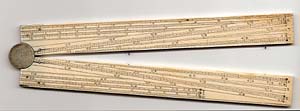



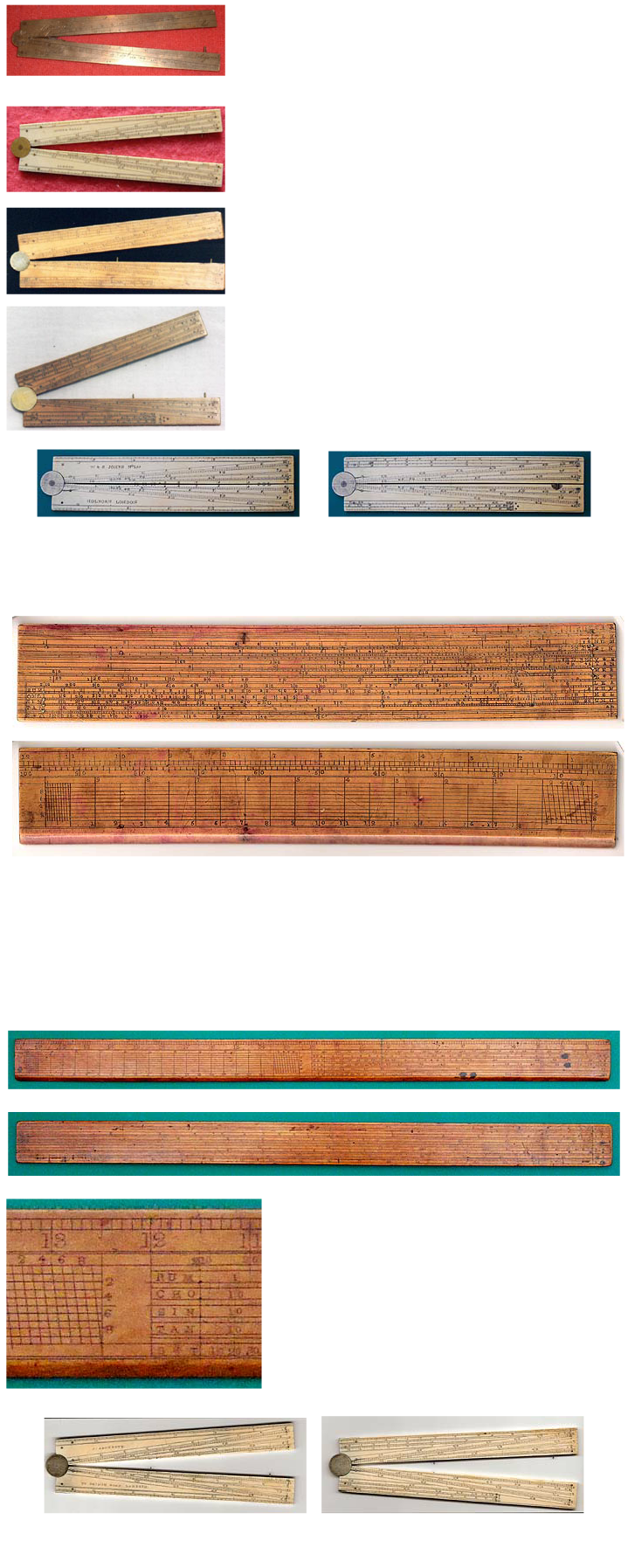

A French, brass sector dating from the eighteenth century. It has scales for line of equal parts, polygons, line of chords, metals, weights of shot and gun calibre. Unlike English sectors, examples of which follow, which were used for general calculation, the French ones were generally intended for gunnery calculations

A fine English, ivory sector by Jacob & Halse, London, date 1809/10. This is very typical of nineteenth century sectors, having scales for inches, decimal feet, lines of sines, tangents, equal parts, chords, numbers (log scales for multiplication), polygons, secants. Like the French sector above it is a six inch size example.

This six inch boxwood sector is from a late nineteenth century set of brass drawing instruments, unsigned. Fewer boxwood sectors seem to have survived than ivory ones.
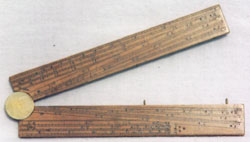
A four and a half inch, boxwood sector from the nineteenth century. Sectors were made in various sizes, but most commonly by far in the six inch size. The smaller, 4 1/2 inch ones would have been made to go with small size instruments, probably a pocket set. The scales are the usual English ones.


12” boxwood Gunter’s scale, probably early 19th century. There are many scales on the upper face:
Left hand side: RUM, CHO, SIN, TAN, S*T. Centre: SEC.
Right hand side: S*R, T*R, NUM, SIN, V*S, TAN, MER, E*P, LEA, RUM, M*L, CHO.
On the lower face are inch and decimal foot scales as well as 1/2” and 1” diagonal scales.
The upper side has brass pins insert at the scale starts and some gauge points to protect the rule from the divider points at these frequently used places.


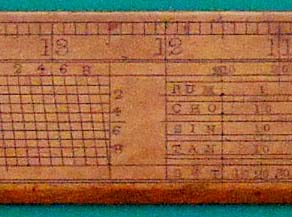
A two foot, boxwood Gunter rule dating from the early nineteenth century. On the upper face it has inch and ½ inch diagonal scales, a two foot inches & tenths ruler, and the following scales: RUM, CHO, SIN, TAN, S*T, SEC, RUM, M*L, CHO. On the lower face are: S*R, T*R, NUM, SIN, V*S, TAN, MER, E*P. This is the most commonly found form of Gunter rule.
Sectors were frequently included in sets of drawing instruments in the eighteenth and nineteenth centuries until made obsolete by the slide rule. There are three types of scale on an English sector: sectoral ones (radiating from the hinge centre), which were used for calculation; plane scales (logarithms, sines, tangents) parallel to the edge; and rules (inches, tenths of feet). I have also added Gunter’s scales to this page since they were also calculating instruments, used mainly for navigation.


Ivory and brass sector signed T & T Blunt, London. Thomas Blunt and son Thomas were in partnership in the first two decades of the 19th century. On the protractors page there is a folding brass protractor that is also by them but is signed Blunt & Son.


Ivory & brass arch-joint sector by Gilbert & Sons, London, signed on the brass arch plate. Gilbert & Sons were working from 1806-1819 at 184 Leadenhall Street. Although the styles overlapped in time to some extent the arch-joint type was generally superseded by the plain joint type (see T & T Blunt example and others above) in the first quarter of the 19 th century. Ivory sectors had generally become the successors to brass ones about the 3rd quarter of the 18th century. The scales on arch joint sectors differ in some respects from the later plain joint ones, and are basically the same as those on the all brass sectors they superseded. The main differences are: (a) the signature is on the opposite face of the rule (although some early plain joint ones are also signed on this face) (b) there is no decimal feet scale on the outer edges of the sector (c) there are four additional scales, inclination of the meridian, chord, latitude and hour on the unsigned face. The signed face is the same as the unsigned face on most plain joint sectors except that the bottom most scale is extended to the end of the rule. A comprehensive description of the sector and its use is given in “A Treatise of Mathematical Instruments” by John Robertson. A reprint of the 1775 3rd edition is available from Flower de Luce Books.


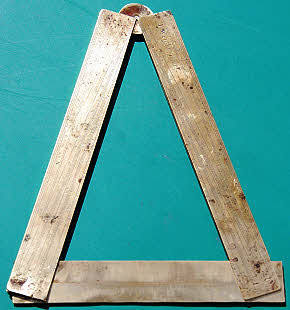
6” brass sector signed T Wright fecit. Thomas Wright was working in London from 1718 to 1747. He died in 1767. The scales on this sector were pretty standard at the time. On the signed face: Chord, linear, secant and polygon sectoral scales and a 2 cycle Gunter (logarithmic) edge scale. On the other
face: Sin, Tan and tan (small angles) sectoral scales and logarithmic sin and tan edge scales. On the outer edge of the fully extended sector there is a 12 inch by tenths ruler.
| Early Sets |
| Traditional Sets |
| Later Sets |
| Major Makers |
| Instruments |
| Miscellanea |
| W F Stanley |
| A G Thornton |
| W H Harling |
| Elliott Bros |
| J Halden |
| Riefler |
| E O Richter |
| Kern, Aarau |
| Keuffel & Esser |
| Compasses |
| Pocket compasses |
| Beam compasses |
| Dividers |
| Proportional dividers |
| Pens |
| Pencils |
| Rules |
| Protractors |
| Squares |
| Parallels |
| Pantographs |
| Sectors |
| Planimeters |
| Map Measurers |
| Miscellaneous |
| Materials Used |
| Who made them |
| Who made these |
| Addiator |
| Addimult |
| Other German |
| USA |
| Miscellaneous |
| Microscopes |
| Barometers |
| Hydrometers & Scales |
| Pedometers |
| Other instruments |
| Workshop Measuring Tools |
| Catalogues & Brochures |


